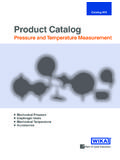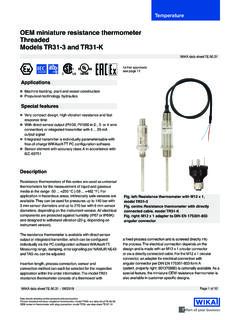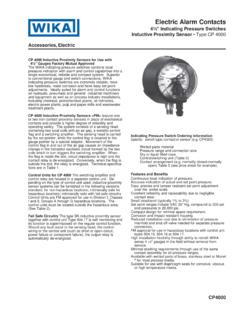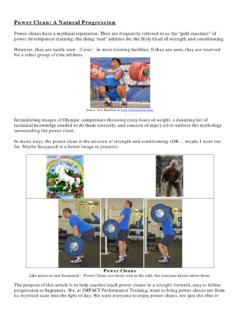Transcription of Product Catalog - WIKA
1 Catalog 900. Product Catalog Pressure and Temperature Measurement Mechanical Pressure Diaphragm Seals Mechanical Temperature Accessories R. Product Catalog 900. Pressure and Temperature Measurement Product Catalog 900. Mechanical Pressure Diaphragm Seals Mechanical Temperature Accessories Printed in the United States of America is a registered trademark of Underwriter's Laboratories. is a registered trademark of Underwriter's Laboratories. XSELTM is a registered trademark of WIKA Instrument Corporation. Halocarbon is a registered trademark of the Halocarbon Products Corporation. Hastelloy is a registered trademark of the Cabot family of companies. Fluorolube is a registered trademark of the Hooker Chemical & Plastics Corporation. Monel and Inconel are registered trademarks of the INCO family of companies.
2 Viton & Teflon are registered trademarks of the DuPont family of companies. Product Catalog > Table of Contents Table of Contents Selecting a Pressure Gauge 2 High Precision Gauges MECHANICAL TEMPERATURE Chemical Compatibility Table 3 6" 58 Bimetal Thermometers Advantages of Liquid-filled Gauges 4 6" 59 Operating Principle 126. WIKA Type Numbers 5 4" 60 General Specifications 127. Ordering Guidelines for 4 " 61 128. Pressure Gauges 6 4 62 128. / 4 63 129. MECHANICAL PRESSURE 10 64 130. Commercial Gauges Calibration Equipment 131. 1 ", 2", 2 ", 4" 7 CPH-6600 65 132. - Fire Sprinkler 4" 8 CPG 1000 66 133. 1 ", 2", 2 " 9 WICP-L100, WICP-M500, WICP-H10K 67 134. 1 , 2 , 2 , 4 10 Ordering Bimetal Thermometers 135. 1 ", 2" 12 DIAPHRAGM SEALS Bimetal Thermometer Options 137.
3 4 " 13 Diaphragm Seal Applications 69 Digital Thermometers 1 ", 2 " 14 Operating Principle 70 138. 1 15 Selection Guidelines 71 Twin-Temp Thermometers Industrial & Process Gauges Assembled Seals 139. 1 ", 2" 16 73 143. 4" 17 74 Gas Actuated Thermometers 10" 18 76 146. 6" 19 78 148. 2 ", 4" 20 Threaded Seals Vapor Actuated Thermometers 3 " 21 80 150. 2", 2 ", 4" 22 81 Industrial Glass Thermometers 2", 2 ", 4" 26 82 152. 4" 28 84 152. 2 , 4" 29 86 153. 2 " 32 88 153. 2 ", 4" 33 89 Thermowells 2 ", 4", 4 ", 6" 34 Flanged Seals / TW15 (Threaded) 159. 4 " 35 90 / TW10 (Flanged) 160. 4 " 36 92 / TW20 (Socket/Weld) 160. 4 ", 6" 37 94 / TW30 (Sanitary) 161. 4 " 39 96 Industrial Glass 162. 4 " 40 98. 4 ", 6" 41 100 ACCESSORIES 4 ", 6" 42 101 Gauge Cocks 163. 4", 6" 43 103 Needle Valves 164.
4 4", 6" 44 105 Mini-Needle Valves 165. Low Pressure Gauges 106 Block & Bleed Valves 166. A2G-10 45 Sanitary Seals Multi-Port Valves 167. A2G-15 46 108 2 " 47 Plastic Seals Snubbers 168. 4" 48 109 Overpressure Protectors 169. 4 " 49 InLine Seals Test Port Plug 170. 4" 50 110 Adaptors 170. Differential & Duplex Gauges 112 Couplings 171. 2 ", 4 " 51 114 Mini-Siphon 171. 2 ", 4 " 52 115 Siphons 172. 6" 53 Seal Accessories CP3000/CP4000 Alarm Contacts 173. 4 ", 6" 54 116 Socket Restrictor 176. 4 ", 6" 55 117 Drag Pointer 176. 4 ", 6" 56 General Seal Information 119 Alarm Contacts 176. 4 ", 6" 57 Pressure Gauge Accessories 177. Standard Dial Layouts 182. For complete detailed information, including electronic pressure, electronic temperature Conversion Chart 184. and ultra high purity products, please visit Cross reference Chart IBC.
5 1. Product Catalog > Selecting a Pressure Gauge Selecting a Pressure Gauge When selecting a pressure gauge, it is important to consider the following factors to ensure safety and accuracy: 1. Pressure fluid composition 2. Pressure fluid temperature 3. Ambient conditions 4. Pressure range 5. Conditions affecting wear of the system 6. Method of mounting 7. Required accuracy 1. Pressure fluid composition Since the sensing element of a pressure gauge may be exposed directly to the measured medium, consider the characteristics of this medium. It may be corrosive, it may solidify at various temperatures or it may contain solids that will leave deposits inside the sensing element. For pressure fluids that will not solidify under normal conditions or leave deposits, a Bourdon tube gauge is acceptable.
6 Otherwise a Sealgauge or diaphragm seal should be used. A chemical compatibility chart follows this section to aid in the selection of the proper sensing element material. 2. Pressure fluid temperature Steam and other hot media may raise the temperature of the gauge components above safe working limits of the sealed joints. In these cases it is recommended that a siphon, cooling tower or diaphragm seal be used in conjunction with the pressure gauge. 3. Ambient conditions The normal ambient temperature range for WIKA pressure gauges is -40oF to +140oF (-40oC to +60oC) for dry or silicone-filled gauges and -4oF to +140oF (-20oC to +60oC) for glycerine-filled gauges. The error caused by temperature changes is + or per 18oF rise or fall, respectively. The reference temperature is 70oF (20oC).
7 The correction is for the temperature of the gauge, not the temperature of the measured medium. Remote gauge mounting using a diaphragm seal and capillary line is one alternative for applications involving extreme ambient temperature. Moisture and weather effects must also be considered. Liquid-filled gauges prevent condensation build up. For outdoor use, stainless steel, brass or plastic cased gauges are recommended. 4. Pressure range A gauge range of twice the working pressure is generally selected. The working pressure in all cases should be limited to 75% of the gauge range. Where alternating pressure and pulsation are encountered, working pressure should be limited to 2/3 of the gauge range. 5. Conditions affecting wear of the system In applications involving severe pressure fluctuation or pulsation, the use of restrictors and/or snubbers is recom- mended.
8 In addition, liquid-filled gauges increase the service life of gauges in these conditions. WIKA liquid- filled gauges are generally filled with glycerine. Silicone for larger temperature extremes and Halocarbon for use with oxidizing agents such as chlorine, oxygen and hydrogen peroxide are also available. 6. Method of mounting Radial (LM) and back (CBM or LBM) connections are available for most WIKA gauges. WIKA stocks gauges with standard NPT threaded connections. Other types such as metric threads, straight threads, hose barbs and special fittings are available as a special order. Pressure gauges should be mounted in the upright position. For applications where the gauge is mounted side ways, horizontally or upside down, contact WIKA Customer Service for gauge type compatibility.
9 7. Required accuracy WIKA stocks gauges with accuracies from 3/2/3% to of span (ASME Grade B to Grade 4A). To ensure safe and accurate gauge selection, you must take all of the above factors into consideration. When in doubt, please do not hesitate to contact your local stocking distributor or WIKA Customer Care for assistance! 1-888-WIKA-USA. 2. Product Catalog > Chemical Compatibility Chart Chemical Compatibility Chart Acetic Acid B Ethyl Acetate A Oxygen A. Acetic Anhydride D Ethyl Cellulose B Paraffin A. Acetone B Ethylene A Phosphoric Acid B. Acetylene B Ethylene Dibromide B Photographic Solutions B. Alcohol A Ethylene Dichloride D Pickling Solutions B. Alums B Ethylene Glycol A Picric Acid B. Aluminum Sulfate B Ferric Nitrate B Picric Acid (dry) B. Ammonia B Ferric Sulfate B Potassium Chloride D.
10 Ammonium Carbonate B Formaldehyde B Potassium Cyanide B. Ammonium Hydroxide D Freon A Potassium Permanganate B. Ammonium Phosphate D Gallic Acid B Prestone A. Beer A Gas (for lighting) A Salicylic Acid A. Benzine A Gasoline A Sea Water C. Benzol A Gasoline (refined) B Silver Nitrate B. Benzyl Alcohol B Glucose C Sodium Carbonate D. Bleach Liquors B Glycerine A Sodium Cyanide D. Bordeaux Mixture A Hydrocyanic Acid B Sodium Hydroxide D. Butane B Hydrogen B Sodium Nitrate B. Butanol A Hydrogen Peroxide B Sodium Peroxide B. Butyric Acid B Kerosene A Sodium Phosphate B. Calcium Bisulfite B Lacquers A Sodium Sulfate B. Calcium Chloride C Lactic Acid B Sodium Sulfide D. Calcium Hydroxide B Lysol B Sodium Sulfite B. Carbon Dioxide(dry) B Magnesium Hydroxide C Sulfur Dioxide D.










